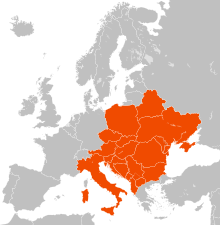Central European Initiative
The Central European Initiative (CEI; French Initiative center-européenne ; in German official language Central European Initiative ) is an informal cooperation between countries in Central Europe in the fields of culture , technology and natural sciences . The CEI initiative is based in Trieste . General Secretary is Giovanni Caracciolo di Vietri. The presidency changes annually within the member states.
history
The CEI initiative was founded in Budapest on November 11, 1989 at the suggestion of Erhard Busek (formerly Austrian Vice Chancellor) by the five states of the Pentagonale when the four foreign ministers of the so-called Visegrád group wanted to initiate further cooperation. The first members were (in alphabetical order) Italy , Yugoslavia , Austria , Hungary and Czechoslovakia . When Poland later joined, skeptics said that most of the areas of the Austro-Hungarian monarchy were now reunited. To this hexagonal further states of Central Eastern Europe were added until 1995 . The CEI is thus the oldest and largest regional organization in Central Europe.
While the cultural and political cooperation was laborious, it was possible to start joint development and research projects in some areas of technology and geosciences . Although not all led to success, steps to standardize z. B. set by norms and the cadastre , which had been lying for a long time in the former Eastern Bloc . The elevation and coordinate systems were partially networked using GPS as well as research in geodynamics . The Czech Republic was the most important initiator, u. a. because it still had supra-regional measurement data from the Comecon .
The often faltering funding by the individual governments was a permanent problem . When the war in the former Yugoslavia began, the hexagonal almost broke on it. After this almost fruitless epoch, the cooperation was re-established around 1993 with the new members Bosnia , Croatia and Slovenia as a Central European Initiative (ZEI, CEI).
While the official cooperation works poorly and the CEI is hardly present in the media, there are many contacts, e.g. B. from research and university institutes to transnational projects. One example of this are the activities of the so-called ALPACA regions in the context of geophysics .
In June 2018, it became known that Austria would leave the Central European Initiative. According to the Foreign Ministry , further participation by Austria is “not expedient”. The format of this organization is no longer "suitable in the same way as before to meet today's European challenges".
Members
Founding members :
-
 Austria (1989)
Austria (1989) -
 Hungary (1989)
Hungary (1989) -
 Italy (1989)
Italy (1989) -
 Yugoslavia (1989–1992)
Yugoslavia (1989–1992)
See also
Web links
- Homepage
- Central European Initiative (website of the Austrian Foreign Ministry) ( Memento from September 13, 2017 in the Internet Archive )
- Harald Kreid: The Central European Initiative in a Changed European Environment (2003)
Individual evidence
- ^ Mission & Objectives of the CEI [1]
- ↑ IDM Info 2/2014 of the Institute for the Danube Region and Central Europe (IDM), Vienna, p. 1
-
↑ In the 25th year of existence (2014) are members: Albania , Bosnia and Herzegovina , Bulgaria , Italy ,
Yugoslavia, Croatia , Macedonia , Moldova , Montenegro , Austria , Poland , Romania , Serbia , Slovakia , Slovenia , the Czech Republic , Ukraine , Hungary , Belarus . - ↑ The CEI member states comprise 240 million people and an area of around 2.4 million km².
- ↑ IDM Info 2/2014 of the Institute for the Danube Region and Central Europe (IDM), Vienna, p. 3f
- ↑ orf.at: Austria leaves the Central European Initiative . Article dated June 11, 2018, accessed June 12, 2018.


